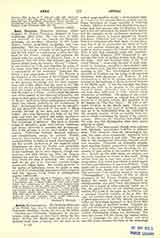

Anna Comnena, Byzantine historian, eldest daughter of Alexius Comnenus, Emperor of Constantinople (1081-1118). She was born in 1083, and received, as was the custom for Byzantine princesses, an excellent education in the Greek classics, history, geography, mythology, and even philosophy. She was married to Nicephorus Bryennius, son of a former pretender to the imperial office, and in 1118 joined in a conspiracy to place her husband on the throne. Failing in her ambition she retired with her mother, the Empress Irene, to a monastery that the latter had founded, and wrote there in fifteen books her famous “Alexias” (‘Alexias). It was finished by 1148, and describes the career of her father, from 1069 to his death in 1118; it is thus a continuation of her husband’s “Historical Materials”, that comes down to 1079. The Princess is the historian of the fortunes of the Comneni family. Her own observations are often valuable by reason of her personal knowledge and the close acquaintance with public affairs that she owed to her high rank, but she also made use of diplomatic correspondence, the reports of her father’s generals and soldiers, and the imperial archives. Critics praise the fullness and choice quality of her historical information; she seems to have gone so far as to utilize in her account of Robert Guiscard a Latin contemporary chronicle, which was written probably by the Archdeacon of Bari. At the same time they point out the panegyrical and ultra-filial character of her work, it being formally devoted to the fame and honor of her father. As a true Byzantine she looks on the Crusades only from the narrow and selfish standpoint of Constantinople, and detests soundly all Latins. The chronology is defective. She loves to describe scenes of splendor, great state-actions, audiences, and feasts, whatever is concrete and picturesque. Nor is she adverse to satire, court gossip, and detraction. Profounder matters, financial, military, and constitutional, escape her purview. Withal, however, Krumbacher calls it “one of the most remarkable efforts of medieval Greek historiography”, the first notable production of the medieval Greek Renaissance set afoot by Psellos and powerfully furthered by the family of the Princess. She strains in her vocabulary for an Attic elegance, though construction and style betray too often the distance between her and the models (Thucydides and Polybius) whom she aims at imitating. She avoids, as unfit for the pen of an historian, uncouth foreign names and vulgar terms. Her studied precision in the matter of hellenizing causes her pages to take on a kind of mummy-like appearance when compared with the vigorous, living Greek of contemporary popular intercourse.
THOMAS J. SHAHAN

